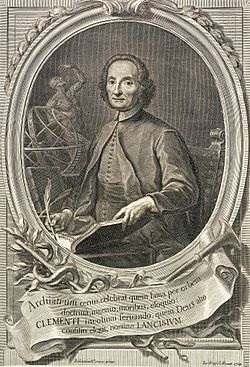Giovanni Maria Lancisi facts for kids
Quick facts for kids
Giovanni Maria Lancisi
|
|
|---|---|

Giovanni Maria Lancisi
|
|
| Born | 26 October 1654 |
| Died | 20 January 1720 (aged 65) |
| Nationality | Italian |
| Alma mater | University of Rome |
| Known for | malaria cardiovascular diseases |
| Scientific career | |
| Fields | medicine anatomy |
Giovanni Maria Lancisi (born October 26, 1654 – died January 20, 1720) was an important Italian doctor. He was an expert in medicine, epidemiology (the study of how diseases spread), and anatomy (the study of the body's structure). Lancisi is famous for connecting mosquitoes to the spread of malaria. He also studied heart diseases and the brain.
Contents
Who Was Giovanni Maria Lancisi?
Giovanni Maria Lancisi was born in Rome, Italy. Sadly, his mother passed away soon after he was born. He was then raised by his aunt in a town called Orvieto.
His Early Life and Education
Lancisi was a very bright student. He studied at the Collegio Romano and the University of Rome. By the time he was just 18 years old, he had already become a qualified doctor! He worked at the Santo Spirito hospital and later became a professor of anatomy at the Sapienza University. He taught there for 13 years.
A Doctor for Popes
Giovanni Maria Lancisi became a personal doctor to three different Popes: Pope Innocent XI, Pope Innocent XII, and Pope Clement XI. Pope Clement XI even gave Lancisi some old anatomy drawings made by another famous anatomist, Bartolomeo Eustachius, back in 1562. These drawings had been lost in the Vatican Library. Lancisi carefully put them together and published them in 1714.
Fighting Diseases
Lancisi spent a lot of time studying how diseases spread. He looked closely at epidemics, which are outbreaks of diseases like malaria and influenza.
Understanding Malaria
In 1717, Lancisi published a book called De Noxiis Paludum Effluviis. In this book, he explained that mosquito-filled swamps were where malaria came from. He suggested that draining these swampy areas could help stop the disease. This was a very important idea for preventing malaria.
Studies on Heart Health
Lancisi also did important work on cardiovascular diseases, which are problems with the heart and blood vessels. His major book on this topic, De Motu Cordis et Aneurysmatibus, was published after he passed away in 1728.
Battling Rinderpest
Early in the 1700s, Lancisi also helped fight an outbreak of rinderpest, a serious disease that affected cattle in Europe. He believed it was better to quickly remove or kill sick animals to stop the disease from spreading. This idea was a big step forward in controlling animal diseases.
A Scientific Disagreement
However, like all scientists, Lancisi wasn't always right. He disagreed with another scientist named Giovanni Cosimo Bonomo. Bonomo had correctly figured out that scabies, a skin condition, was caused by tiny parasites. But Lancisi thought it was caused by something else inside the body. Because Lancisi was so respected and powerful, Bonomo's correct discovery was not widely accepted at the time. It took many years for Bonomo's findings to be recognized.
Understanding the Brain
Lancisi also studied the human brain. He described a part of the brain called the corpus callosum. He believed this part of the brain was where our thoughts, decisions, and judgments happened. He even named some parts of the brain after himself, like the "striae lancisi." He thought these parts helped connect our thoughts to our senses.

